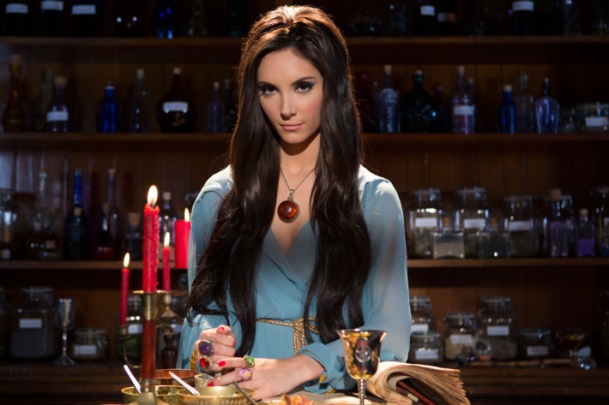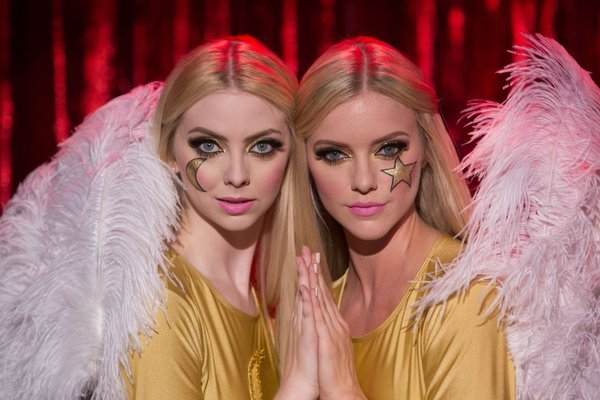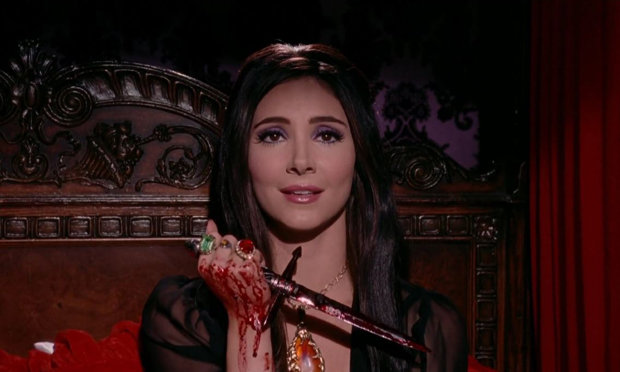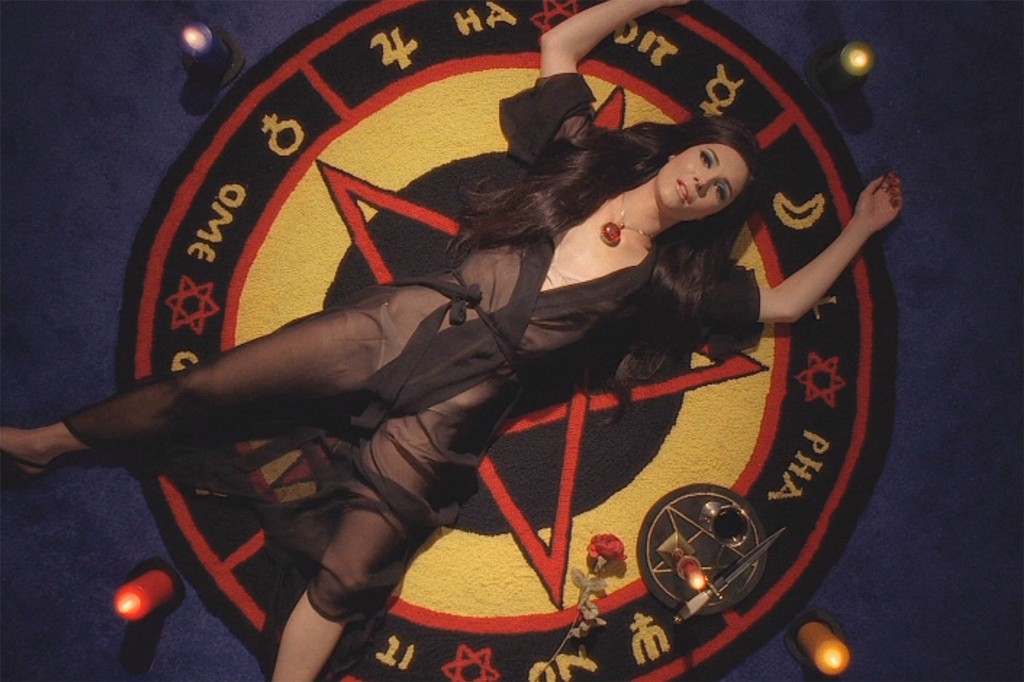
“Got hair as black as night
Got a skirt that’s ooh, so tight
Tellin’ you, I’ve got an itch…
She’s my witch.”
– Kip Tyler, ‘She’s My Witch’
For thousands of years there has been no symbol of feminine power more polarizing than the witch. Societal perceptions of witchcraft have swung wildly from reverence to scorn and back again, as female healers and magicians are viewed as either benevolent sages or as cunning manipulators seeking only to castrate men, both figuratively and (quite) literally. The witch shows us all we love – and all we fear – about the feminine.
Witches are also no strangers to cinema, but few films or TV shows can boast a protagonist as glamorous and enigmatic as Elaine, the titular sorceress of writer-director-producer-editor Anna Biller’s 2016 feminist horror-comedy The Love Witch.
The film opens with Elaine (Samantha Robinson) driving on a picturesque northern California highway. Everything about Elaine looks perfect, from her red dress to her vintage cherry-colored Mustang convertible to her iconic makeup: Blue eye-shadow, winged black eyeliner, false lashes, heavy rouge, and glossy coral lips. But it’s soon clear that something is off about our heroine, that her perception of reality is skewed. Even as she contemplates all she’s learned about men and love since the death of her husband, Jerry, she doesn’t acknowledge what the audience clearly sees: Jerry was murdered – by Elaine. Finally, she arrives at her new home, where she meets Trish (Laura Waddell), a more grounded woman who regards Elaine’s over-the-top beauty with equal parts wistful envy and healthy skepticism.

Trish invites Elaine to the “ladies only” Victorian tea room, where the two discuss Elaine’s approach to relationships: Namely, give men what they want – inhabit the feminine archetype to a T – and they’ll love you. As Trish cocks an eyebrow, Elaine posits that sex, nurturing, and flattery are necessary to properly bewitch a man – a lesson she learned the hard way when Jerry left her. “The day he left me was the day that I died,” she declares. “But then I was reborn as a witch!”
While she spends her days painting, casting spells, and eating cakes in a variety of stunning outfits (Biller also meticulously oversaw costumes, makeup, music, and set design – right down to personally knitting the film’s pentagram rug and painting some of the portraits that fill Elaine’s apartment), Elaine never loses sight of her goal: Find a man, make him love her, and make damn sure he never leaves her. Her first victim is Wayne, a professor and self-proclaimed lothario who she kills by dosing him with psychedelics, followed by Trish’s husband, Richard, who is driven to despair and eventual suicide by his obsession with Elaine. Finally, Elaine meets her “dream man” – Griff, the staunchly masculine, no-nonsense police detective investigating her involvement in Wayne’s death. Along the way, we learn about Elaine’s backstory – her abusive father, her loveless marriage, her exploitation at the hands of her paternalistic coven’s leader, a man who preaches that “a woman’s greatest power lies in her sexuality” even as he rapes Elaine on the altar – and how creating the persona of “the Love Witch” was a direct response to that abuse, manipulation, and assault.

One of the most striking aspects of the film is its bold stylistic choices, which have led some critics to declare The Love Witch a parody or pastiche. In fact, Biller has said that the film is neither and is not intended to be a period piece, beyond the basic aesthetic inspiration she drew from the occult films that proliferated in the ‘60s and ‘70s. Shot in widescreen 35mm and utilizing lighting techniques gleaned from classic cinema, the film does appear decidedly retro to modern eyes, but part of its cleverness is the way it challenges viewers to see beyond its surface, just as men would be well advised to look beyond Elaine’s beautiful exterior.
As a director, Biller is unafraid to bring deeply feminine imagery to the screen. Two of the most notable examples are the aforementioned tea room scene and Elaine and Griff’s Ren Faire inspired mock wedding. Of these scenes, she told Filmmaker Magazine: “People can’t believe the tearoom and the renaissance fair scenes — people think these are weird feminine-leaning things I threw in the movie just to be insane. But those are the thematic backbone of the film…[Those] scenes are expressions of [Elaine’s] inner fantasy life coming on the screen.” The tendency of some viewers to dismiss these crucial thematic scenes as mere “fluff” illustrates how seldom we see an unmistakably feminine aesthetic on screen, and how jarring – and exciting – it can feel when we do.

My own interest in what I would call the performance of femininity as an act of empowerment dates back to the ‘90s, when many of my favorite musicians did just that. Third wave feminism met punk rock in riot grrrl, a short-lived but extremely potent movement in which bands delivered radical gender politics with a schoolgirl’s playground sneer. Don’t reject or transcend your girlhood, they argued. Change the connotations of girlhood instead.
Other bands, like Hole and Babes in Toyland, featured frontwomen who performed while wearing bright red lipstick, tattered baby doll dresses, and bleached blonde hair to play up their gender almost to the point of the grotesque, a la What Ever Happened to Baby Jane? Even solo artists like Polly Jean Harvey and Tori Amos made their mark in part by giving voice to vilified female archetypal figures like Eve and Mary Magdalene. These women seemed less interested in infiltrating rock music’s boys’ club and more interested in burning down the clubhouse with all of the boys inside.

But there is nothing punk or edgy about the way Elaine performs femininity. She is not commenting on or subverting anything – she is simply trying to play the game, to do what she believes she must in order to win the adoration of a man, in order to be loved. A more apt parallel can be drawn between Elaine and the music and persona of Lana del Rey, a frequently misunderstood and oft-derided artist who has become loosely associated with The Love Witch among fans due to her pretty-when-you-cry brand of languid beauty and her almost nihilistically romantic lyrics. “If I get a little prettier, can I be your baby?” she coos in 2012’s “Gods and Monsters,” only moments after branding herself as “an angel looking to get fucked hard.” It’s not hard to imagine the song playing in Elaine’s boudoir as she undergoes her own daily ritual transformation from lonely young woman to glamorous witch.
Indeed, The Love Witch reminds us of the very etymology of the word “glamour,” a term that connotes not just beauty or sex appeal but enchantment, illusion, and witchcraft. Elaine’s magic is not limited to her spells, potions, and witch bottles – her entire persona is a form of love magic; even her wardrobe is a weapon, as when she uses the interior of her rainbow-lined coat to enchant a heavily tripping Wayne before their sexual encounter.

While Elaine looks invariably gorgeous, we are also offered glimpses “behind the curtain” at the rigorous effort that her character puts in to present herself the way she does, such as when Trish discovers some of her “tools of the trade,” including a full wig displayed on her vanity. In another scene, Elaine buries a witch bottle that she’s made incorporating her own urine and a used tampon as ingredients; both bodily fluids are shown on screen. Amusingly, these scenes elicited an audibly shocked response from some men in the audience when I first saw the film. For them, it seems that simply being reminded that Elaine is a real person and not just a fantasy made flesh is so offensive to their cinematic expectation of Beautiful Woman as Passive Object that it appears to be the true horror of the film. In fact, exposing and questioning those very expectations – and how damaging they can be to men and women alike – lie at the heart of The Love Witch.
In an interview with The A.V. Club, Biller discusses how the dehumanizing demands of a patriarchal society manifest in Elaine: “This is what men demand of women. It’s kind of a social irony. They want this woman who’s beautiful, she’s perfect, she looks gorgeous all the time, she’s subservient, she doesn’t talk too much, she cooks for them, she’s loving. What if you took that literally? What if you really became that thing that men want you to be? You’d be a Frankenstein monster. That’s where the comedy comes from — the comedy comes from her literal interpretation of what is demanded of her.” And, I would argue, the horror comes from the emotional fragmentation, insanity, and violence that result when acting on that literal interpretation fails to help her achieve her intended result.

Every man who falls for Elaine praises her for the way she looks, for the way she makes them feel. Even though all she wants is to be seen and to experience romantic connection, she remains an enigma to her lovers, failing again and again to achieve true intimacy with them. They don’t want to love her; they only want to possess her. When Richard asks, “Who are you?” Elaine replies ecstatically, “I’m the love witch! I’m your ultimate fantasy!” In that moment, she wills herself to believe that she is no more than that, that she needs no more than that. But it is a victory that is unsustainable, unrewarding, and profoundly hollow. No matter how much she gives them, it’s never enough, and she quickly grows to resent men for the very attention she herself lavishes upon them. “Poor baby. Poor, poor baby,” she repeatedly coos to lover after lover, and the more she says it the less she means it, until the phrase is practically dripping with disdain.
“She is nearly sexually assaulted by an angry mob at a burlesque club after her crimes are uncovered, and – most devastating of all – she fails to bewitch Griff after he sees her for who she really is: A murderer.”
Unfortunately, Elaine’s witchcraft is no match for the insidiously damaging effects of the patriarchy. She is nearly sexually assaulted by an angry mob at a burlesque club after her crimes are uncovered, and – most devastating of all – she fails to bewitch Griff after he sees her for who she really is: A murderer. The force of his gaze, bereft of all affection, is too much for her to withstand; Elaine withers under his stare to the extent that she tries to physically shield herself from it. In the end, our heroine is left alone with blood on her hands and a sad smile on her lips as she descends fully into madness, her reality too painful and ugly for even a self-proclaimed powerful “love witch” to bear. Despite her best efforts, Elaine has found no magic strong enough to overcome the crushing burden of being female in a society that leaves little room for women to be seen as fully human – and that, finally, is the film’s true horror.

Melissa Pleckham is a writer and performer living in Los Angeles with her husband and their adopted son, a tuxedo cat named Sandya. She wrote and starred in the comedy short film Group, as well as the micro-short Nothing Happens, which was an Official Selection of both the Midsummer Scream Halloween Festival in Long Beach, CA and the inaugural Salem Horror Fest in Salem, MA. Her fiction and poetry have been featured on HelloHorror and in the collection Entombed in Verse from FunDead Publications, and her screenplay Blackstone was a semi-finalist in the 2017 Screamfest Horror Film Festival Screenplay Competition.
Her thoughts on Halloween and horror films can be found on her blog, Spooky Little Girl; follow her on Instagram and Twitter for adorable cat pics and general California creepiness.

Leave a comment